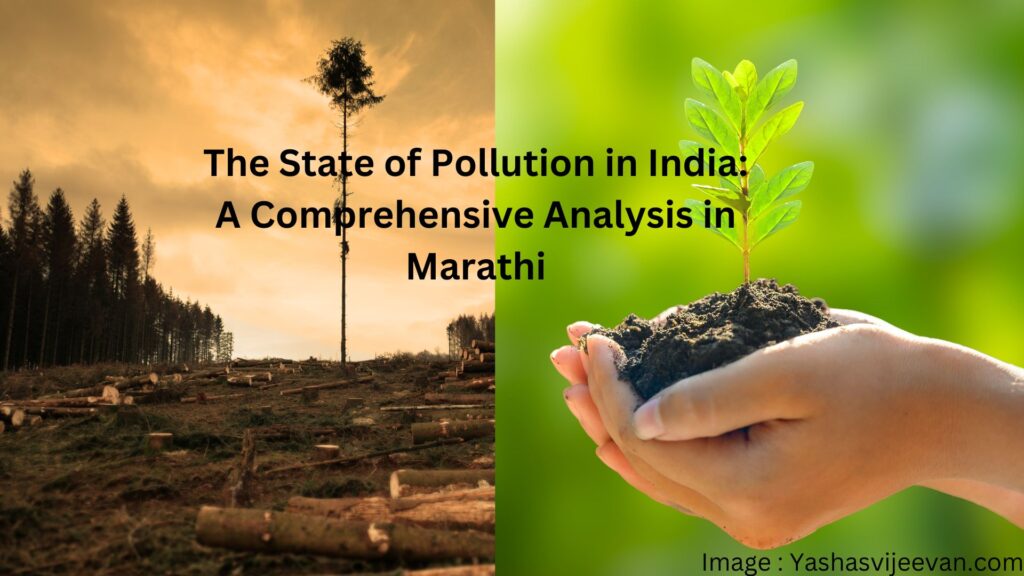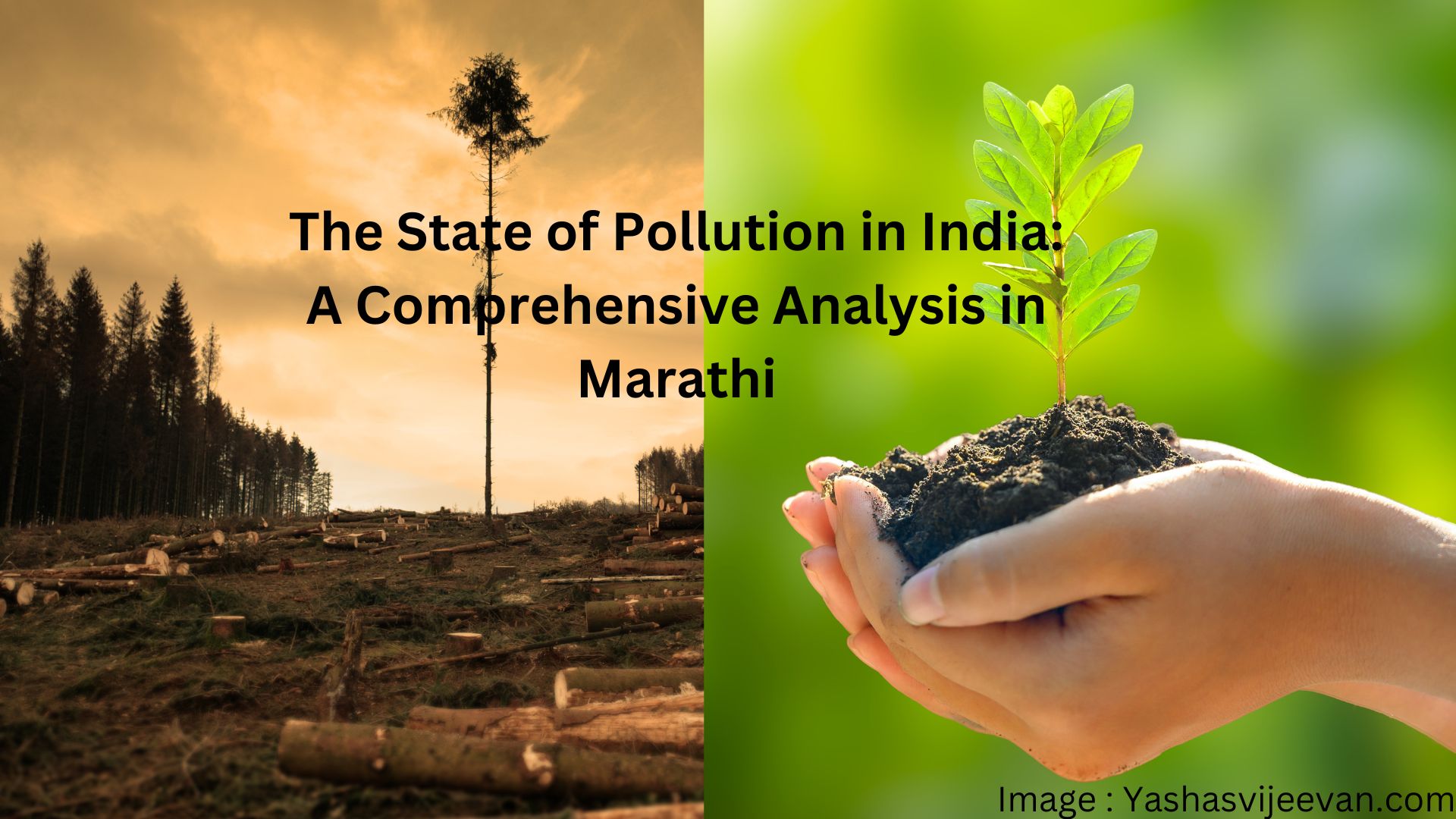
भारतातील प्रदूषणाची स्थिती: एक व्यापक विश्लेषण |The State of Pollution in India: A Comprehensive Analysis in Marathi
वर्णन: वायू आणि जल प्रदूषणापासून ते कचरा व्यवस्थापन समस्यांपर्यंत आज भारतासमोर असलेल्या पर्यावरणीय आव्हानांचे गुंतागुंतीचे जाळे एक्सप्लोर करा आणि आपल्या ग्रहाच्या भविष्याचे रक्षण करण्यासाठी संभाव्य उपायांचा शोध घ्या.
परिचय
समृद्ध सांस्कृतिक वारसा आणि वैविध्यपूर्ण परिसंस्थेचा भूमी असलेला भारत एक भयंकर आव्हानाचा सामना करत आहे: प्रदूषण. एक व्यावसायिक ब्लॉगर म्हणून, या विषयात खोलवर जाणे, त्यातील बारकावे, परिणाम आणि संभाव्य उपाय समजून घेणे महत्त्वाचे आहे. या ब्लॉगचे उद्दिष्ट भारतातील प्रदूषणाच्या सद्यस्थितीचे सर्वसमावेशक विश्लेषण प्रदान करणे आहे, ज्यामध्ये वायू प्रदूषण, जल प्रदूषण, कचरा व्यवस्थापन आणि बरेच काही समाविष्ट आहे.
वायू प्रदूषण: विषारीपणात श्वास घेणे
भारतातील सर्वात गंभीर पर्यावरणीय समस्यांपैकी एक म्हणजे वायू प्रदूषण. दिल्ली, मुंबई आणि कोलकाता यांसारखी प्रमुख शहरे अनेकदा त्यांच्या धोकादायक हवेच्या गुणवत्तेसाठी, विशेषत: हिवाळ्याच्या महिन्यांत मथळे बनवतात. वायू प्रदूषणाचे मुख्य कारण म्हणजे वाहनांचे उत्सर्जन, औद्योगिक क्रियाकलाप, बांधकामाची धूळ आणि शेती जाळणे. हे प्रदूषक केवळ मानवी आरोग्यावरच परिणाम करत नाहीत, ज्यामुळे श्वसनाचे आजार होतात आणि आयुर्मान कमी होते परंतु जैवविविधता आणि हवामानाच्या नमुन्यांवर देखील परिणाम होतो.
जल प्रदूषण: जलचर जीवन आणि मानवी आरोग्यासाठी धोका
गंगा आणि यमुना यांसारख्या नद्यांसह भारतातील जलस्रोत, औद्योगिक विसर्जन, कृषी प्रवाह आणि अपर्याप्त सांडपाणी प्रक्रियांमुळे मोठ्या प्रमाणावर प्रदूषित आहेत. हे प्रदूषण केवळ जलचरांनाच हानी पोहोचवत नाही तर पिण्याच्या आणि दैनंदिन कामांसाठी या जलस्रोतांवर अवलंबून असलेल्या मानवांसाठी गंभीर आरोग्य धोके देखील निर्माण करतात. दूषित पाणी असलेल्या भागात कॉलरा आणि टायफॉइड सारखे जलजन्य रोग प्रचलित आहेत, पाणी व्यवस्थापनासाठी कठोर नियम आणि सुधारित पायाभूत सुविधांची तातडीची गरज अधोरेखित करते.
जमीन प्रदूषण आणि कचरा व्यवस्थापन
घनकचऱ्याची अयोग्य विल्हेवाट हा भारताच्या प्रदूषणाच्या समस्यांमध्ये आणखी एक महत्त्वपूर्ण योगदान आहे. लँडफिल ओव्हरफ्लो होत आहेत, ज्यामुळे माती दूषित होते आणि हानिकारक रसायने भूजलात मिसळतात. प्लॅस्टिक प्रदूषण, विशेषतः, जागतिक चिंतेचा विषय बनला आहे, एकेरी वापरल्या जाणाऱ्या प्लॅस्टिकमुळे जलमार्ग अडतात आणि वन्यजीवांना हानी पोहोचते. कचरा विलगीकरण, पुनर्वापराचे उपक्रम आणि पर्यावरणपूरक पर्यायांना प्रोत्साहन देणे यासारखे प्रयत्न हे शाश्वत कचरा व्यवस्थापनाच्या दिशेने महत्त्वाचे पाऊल आहेत.
सार्वजनिक आरोग्य आणि अर्थव्यवस्थेवर परिणाम
प्रदूषणाचे सार्वजनिक आरोग्य आणि अर्थव्यवस्थेवर दूरगामी परिणाम होतात. प्रदूषणाशी संबंधित आरोग्य समस्यांमुळे आरोग्यसेवा खर्चात वाढ होते, आजारी दिवसांमुळे उत्पादकता कमी होते आणि प्रभावित व्यक्तींचे जीवनमान कमी होते. शिवाय, पर्यावरणाच्या ऱ्हासामुळे शेतीमध्ये व्यत्यय, पाणी टंचाई आणि हवामान-संबंधित आपत्ती येऊ शकतात, या सर्वांचा आर्थिक परिणाम होतो. प्रदूषणावर उपाय केल्याने केवळ सार्वजनिक आरोग्य सुधारत नाही तर अधिक लवचिक आणि टिकाऊ अर्थव्यवस्थेला चालना मिळते.
सरकारी उपक्रम आणि धोरण फ्रेमवर्क
भारत सरकारने प्रदूषणाचा सामना करण्यासाठी विविध उपक्रम आणि धोरणे राबवली आहेत. नॅशनल क्लीन एअर प्रोग्राम (NCAP) चे उद्दिष्ट शहरांमधील वायू प्रदूषण पातळी कमी करणे, उत्सर्जनाच्या कठोर मानकांवर लक्ष केंद्रित करणे, इलेक्ट्रिक वाहनांना प्रोत्साहन देणे आणि हवेच्या गुणवत्तेचे निरीक्षण वाढवणे आहे. त्याचप्रमाणे, नमामि गंगे कार्यक्रमाचे लक्ष्य गंगा नदीचे पुनरुज्जीवन, सांडपाणी प्रक्रिया प्रकल्प आणि प्रदूषण कमी करण्याच्या उपाययोजनांवर भर देण्यात आला आहे. हे प्रयत्न, आंतरराष्ट्रीय सहयोग आणि तांत्रिक प्रगतीसह, प्रदूषणाचा सामना करण्यासाठी सक्रिय दृष्टिकोन दर्शवितात.
समुदाय सहभाग आणि शाश्वत पद्धती
सरकारी हस्तक्षेप महत्त्वाचा असला तरी वैयक्तिक आणि समुदायाचा सहभाग तितकाच महत्त्वाचा आहे. पावसाचे पाणी साठवणे, अक्षय ऊर्जेचा अवलंब करणे आणि कचऱ्याची जबाबदारीने विल्हेवाट लावणे यासारख्या शाश्वत पद्धतींचा अवलंब केल्याने पर्यावरणावरील परिणाम लक्षणीयरीत्या कमी होऊ शकतो. भविष्यातील पिढ्यांसाठी पर्यावरणीय कारभाराची संस्कृती वाढवून, नागरिकांमध्ये पर्यावरणाविषयी जागरूक वर्तन वाढवण्यात शिक्षण आणि जागरूकता मोहिमा महत्त्वाची भूमिका बजावतात.
तांत्रिक नवकल्पना आणि ग्रीन सोल्यूशन्स
प्रदूषणाच्या आव्हानांना सामोरे जाण्यासाठी तंत्रज्ञान निर्णायक भूमिका बजावत आहे. वायु शुद्धीकरण, जल शुद्धीकरण प्रणाली आणि शाश्वत शेती पद्धती यासारख्या नवकल्पना प्रदूषणाचे प्रतिकूल परिणाम कमी करण्यासाठी महत्त्वपूर्ण आहेत. शिवाय, हरित तंत्रज्ञानामध्ये गुंतवणूक करणे आणि स्वच्छ ऊर्जा उपक्रमांना पाठिंबा देणे स्वच्छ, हरित भविष्याचा मार्ग मोकळा करू शकतो.
निष्कर्ष: स्वच्छ, हरित भविष्याकडे
शेवटी, भारतातील प्रदूषणाची स्थिती तातडीने लक्ष देण्याची आणि सर्व भागधारकांकडून एकत्रित प्रयत्नांची मागणी करते. आपल्या पर्यावरणाचे रक्षण करण्यासाठी धोरणकर्ते आणि उद्योगपतींपासून वैयक्तिक नागरिकांपर्यंत प्रत्येकाची भूमिका आहे. शाश्वत पद्धतींना प्राधान्य देऊन, ग्रीन सोल्युशन्समध्ये गुंतवणूक करून आणि कठोर नियमांचे समर्थन करून, आम्ही प्रदूषणाचे परिणाम कमी करू शकतो आणि भारत आणि जगासाठी स्वच्छ, हरित भविष्यासाठी मार्ग मोकळा करू शकतो.
English : The State of Pollution in India: A Comprehensive Analysis by yashasvijeevan.com
Description: Explore the intricate web of environmental challenges India faces today, from air and water pollution to waste management issues, and delve into the potential solutions to safeguard our planet’s future.
Introduction
India, a land of rich cultural heritage and diverse ecosystems, is grappling with a daunting challenge: pollution. As a professional blogger, it’s crucial to delve deep into this topic, understanding its nuances, impacts, and potential solutions. This blog aims to provide a comprehensive analysis of the current state of pollution in India, covering aspects like air pollution, water pollution, waste management, and more.
Air Pollution: Breathing in Toxicity
One of the most pressing environmental issues in India is air pollution. Major cities like Delhi, Mumbai, and Kolkata often make headlines for their hazardous air quality levels, especially during winter months. The primary contributors to air pollution are vehicular emissions, industrial activities, construction dust, and agricultural burning. These pollutants not only affect human health, leading to respiratory diseases and reduced life expectancy but also impact biodiversity and climate patterns.
Water Pollution: Threat to Aquatic Life and Human Health
India’s water bodies, including rivers like the Ganges and Yamuna, are heavily polluted due to industrial discharge, agricultural runoff, and inadequate sewage treatment. This pollution not only harms aquatic life but also poses serious health risks to humans who rely on these water sources for drinking and daily activities. Waterborne diseases like cholera and typhoid are prevalent in areas with contaminated water, highlighting the urgent need for stricter regulations and improved infrastructure for water management.
Land Pollution and Waste Management
The improper disposal of solid waste is another significant contributor to India’s pollution woes. Landfills are overflowing, causing soil contamination and leaching harmful chemicals into groundwater. Plastic pollution, in particular, has become a global concern, with single-use plastics clogging waterways and harming wildlife. Efforts like waste segregation, recycling initiatives, and promoting eco-friendly alternatives are crucial steps toward sustainable waste management.
Impact on Public Health and Economy
Pollution has far-reaching consequences on public health and the economy. Health problems related to pollution result in increased healthcare costs, productivity losses due to sick days, and a diminished quality of life for affected individuals. Moreover, environmental degradation can lead to disruptions in agriculture, water scarcity, and climate-related disasters, all of which have economic implications. Addressing pollution not only improves public health but also fosters a more resilient and sustainable economy.
Government Initiatives and Policy Framework
The Indian government has implemented various initiatives and policies to tackle pollution. The National Clean Air Programme (NCAP) aims to reduce air pollution levels in cities, focusing on stricter emission standards, promoting electric vehicles, and enhancing air quality monitoring. Similarly, the Namami Gange program targets the rejuvenation of the Ganges river, emphasizing sewage treatment plants and pollution abatement measures. These efforts, coupled with international collaborations and technological advancements, signal a proactive approach to combatting pollution.
Community Participation and Sustainable Practices
While government interventions are crucial, individual and community participation is equally important. Adopting sustainable practices such as rainwater harvesting, renewable energy adoption, and responsible waste disposal can significantly reduce environmental impact. Education and awareness campaigns play a vital role in promoting eco-conscious behavior among citizens, fostering a culture of environmental stewardship for future generations.
Technological Innovations and Green Solutions
Technology continues to play a pivotal role in addressing pollution challenges. Innovations like air purifiers, water purification systems, and sustainable agriculture practices are instrumental in mitigating pollution’s adverse effects. Moreover, investing in green technologies and supporting clean energy initiatives can pave the way for a cleaner, greener future.
In conclusion, the state of pollution in India demands urgent attention and concerted efforts from all stakeholders. From policymakers and industry leaders to individual citizens, everyone has a role to play in safeguarding our environment. By prioritizing sustainable practices, investing in green solutions, and advocating for stricter regulations, we can mitigate pollution’s impacts and pave the way for a cleaner, greener future for India and the world.




